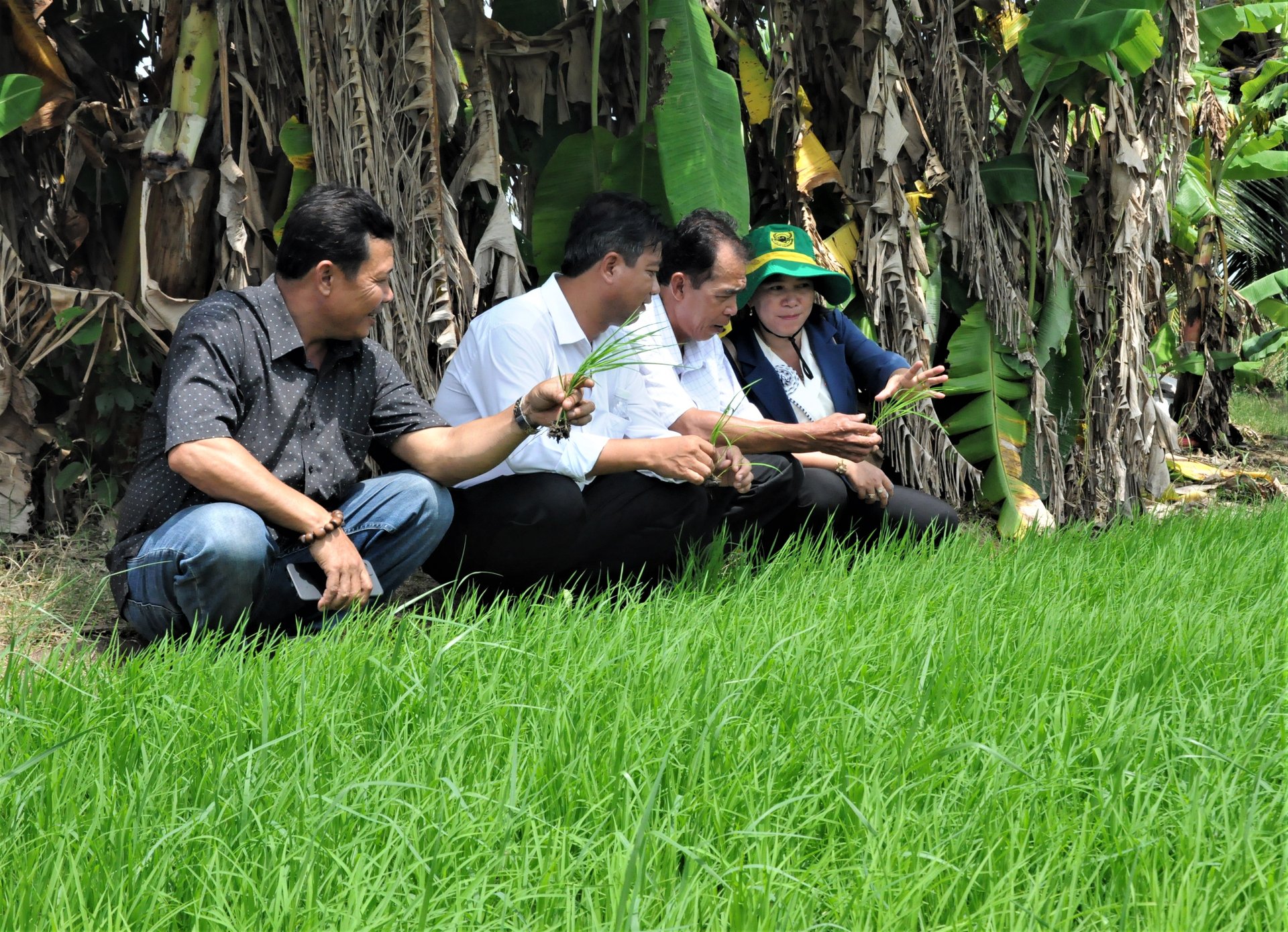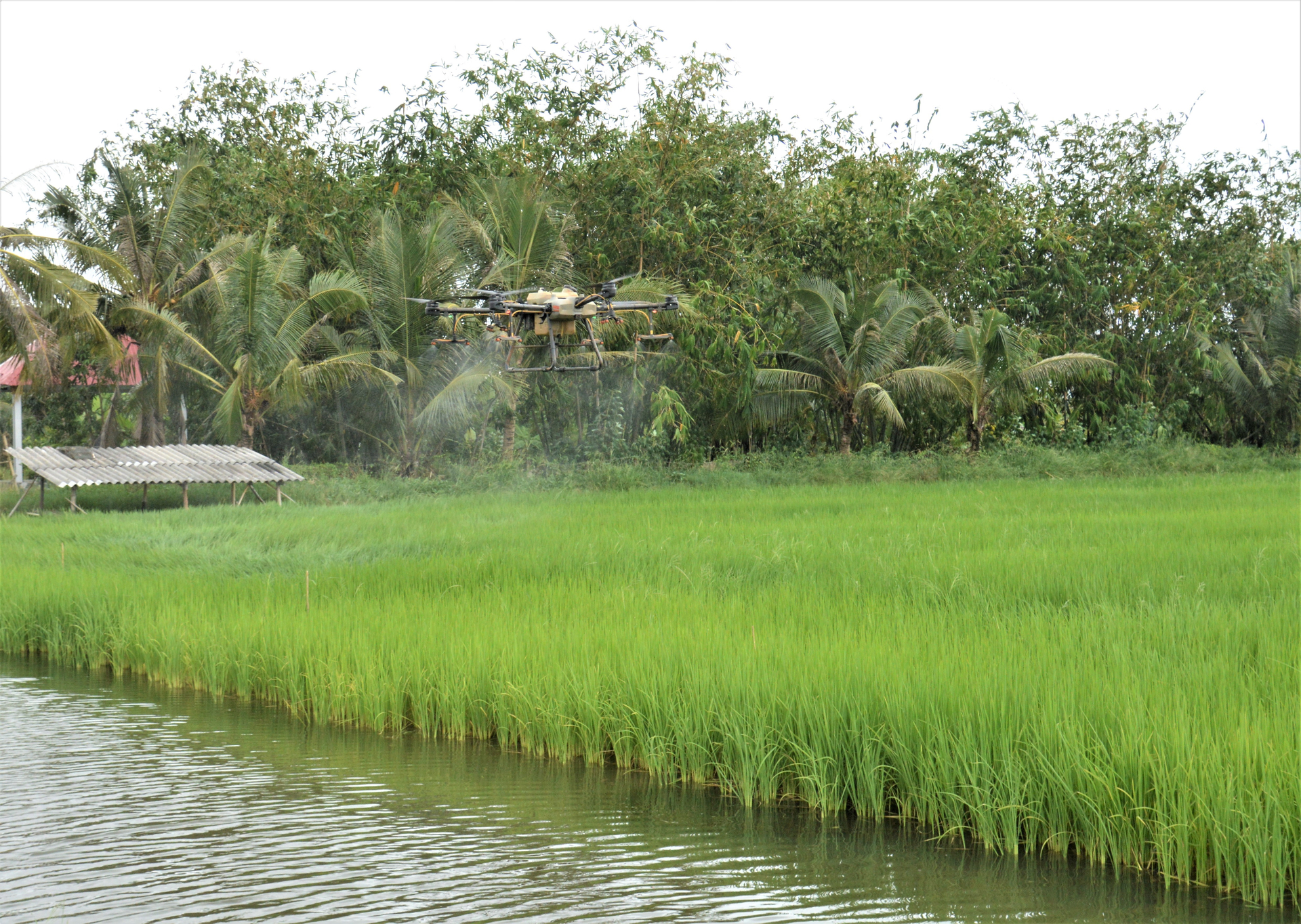May 24, 2025 | 16:26 GMT +7
May 24, 2025 | 16:26 GMT +7
Hotline: 0913.378.918
May 24, 2025 | 16:26 GMT +7
Hotline: 0913.378.918

Farmers in An Minh district are actively utilizing rainwater for salinity control in their fields in preparation for the 2023-2024 rice-shrimp crop. Photo: Trung Chanh.
According to Mr. Le Huu Toan, Deputy Director of Kien Giang province's Department of Agriculture and Rural Development, the province aims to achieve a rice output of at least 4.4 million metric tons in compliance with the 2023 grain production targets. Accordingly, over 90% of the production area is expected to meet high-quality rice production standards. Most notably, the province has supported farmers and agricultural cooperatives in standardized rice production with a focus on good agricultural practices, organic farming, and production unit codes in combination with origin traceability.
During the 2022-2023 Winter-Spring and Main crops, Kien Giang province successfully produced 27,187 hectares of rice meeting SRP, organic, VietGAP, GlobalGAP standards. Additionally, strict control over residues and the assurance of food safety were maintained to meet the demands of export markets including the EU, the United States, and Japan, among others. Namely, efforts were directed towards the production of standardized rice across 1,670 hectares during the Winter-Spring crop. This area included 1,474 hectares of transitioning certified organic rice production areas, and 196 hectares of VietGAP-compliant rice production areas. These standardized rice production efforts were the results of the collaborative partnerships with various local businesses, including Dai Duong Xanh Company, Dien Tin Company, Ho Quang Company, and the Organic Agricultural Cooperative in Rach Gia.

Farmers in An Minh district pruning and nurturing the rice seedlings to achieve the desired size before transplanting them into the shrimp farming land. Photo: Trung Chanh.
During the 2022-2023 Winter-Spring crop, the province expanded the area of standardized rice production to 25,517 hectares. Accordingly, Loc Troi Group initiated production contracts, established production linkages, and performed technological transfer on 8,716 hectares to the EU and 318 hectares to the US; Trung An High-Tech Agricultural Company produced GlobalGAP-compliant rice on 400 hectares and organic rice on 200 hectares. Additionally, various companies have collaborated to produce rice on 15,783 hectares, with a focus on effective residue control to meet export and domestic consumption requirements. These collaborators include Loc Troi Group, Dien Tin Company, Kitoku Company, and Xuan Phuong Limited Liability Company.
Kien Giang province initiated rice production on 1,334 large paddy fields in 2023, for a total area of 167,225 hectares. These figures represent an increase of 641 large paddy fields and 57,893 hectares compared to 2022. Most notably, 1,026 of these large paddy fields, which covered an area of nearly 120,700 hectares, were associated with businesses' consumption contracts. The purchasing prices in the contracts were favorable as they consistently exceeded the market rates due to the effective control of residues, safe food production, and compliance with export standards to markets in the EU, the US, Japan, and others.

Businesses have contracted 260 hectares of organic rice production area on shrimp-farming land in An Minh district for the 2023-2024 Winter-Spring crop, with the aim of producing premium rice for domestic consumption as well as export. Photo: Trung Chanh.
Kien Giang province boasts the largest rice-shrimp production area in the Mekong Delta region, covering an area of over 102,000 hectares. These integrated areas are predominantly located in the U Minh Thuong region, which is highly conducive to organic rice production. Accordingly, An Minh district contains largest rice-shrimp production area in the province at over 39,000 hectares, with an annual rice production area of 25,000 hectares.
According to Mr. Le Van Khanh, Head of Agriculture and Rural Development in An Minh district, the district has been transitioning to rice-shrimp integrated farming for over twenty years since 2001. The district has effectively planned and executed the production model, resulting in a stable implementation of the shrimp-rice farming practiced by the local community. The district's successful rice production in recent years has contributed to the increasing effectiveness of the rice-shrimp farming model. Namely, An Minh district sowed and harvested an area of 25,579 hectares for the 2022-2023 Winter-Spring crop, with an estimated yield of 130,000 metric tons. Primary varieties of fragrant and specialty rice, including ST5, ST24, and ST25, constituted 30% of the yield, with the remainder comprising local seasonal rice varieties such as Mot Bui Do among others.

Kien Giang province boasts the largest rice-shrimp production area in the Mekong Delta region, which spans over 102,000 hectares. This vast expanse provides a highly favorable environment for meeting export standards, with a focus on organic rice production. Photo: Trung Chanh.
According to Mr. Khanh, An Minh district plans to deploy rice-shrimp integrated farming on an area of 27,000 hectares for the 2023-2024 crop. Farmers are currently utilizing rainwater for the desalination process, resulting in more than 29,000 hectares of production area being treated. Subsequently, the total sowed area reached nearly 24,000 hectares by the end of September, with over 17,500 hectares undergoing trimming and transplanting, whereas the remainder are directly sown.
Agricultural cooperatives in An Minh district have recently formed partnerships for standardized rice production and signed contracts for rice consumption with several companies including Dai Duong Xanh, Ho Quang Tri Company, and Tan Long Group. These contracts, which focus on ST5, ST24, and ST25 rice varieties, have generated significant profits for local farmers. Most notably, businesses have contracted 260 hectares of organic rice production area on shrimp-farming land for the 2023-2024 Winter-Spring crop, with the aim of producing premium rice for domestic consumption as well as export.
Kien Giang province currently has a total of 363 production unit codes, which cover an area of 12,122 hectares and 15 different types of crops. Accordingly, 165 production unit codes are designated for export, and the remaining 198 domestic codes are pending approval for export by the Department of Plant Protection. A total of 302 production unit codes have been issued for nearly 6,500 hectares of rice production area. These production unit codes are designated for export to the EU, the US, Japan, China, Malaysia, and Singapore.
Translated by Nguyen Hai Long

(VAN) The People's Committee of Tra Vinh province has approved an adjustment to the investment policy for the Green Hydrogen Plant project, increasing its area to approximately 52.76 hectares.
![Reducing emissions from rice fields: [2] Farmers’ commitment to the soil](https://t.ex-cdn.com/nongnghiepmoitruong.vn/608w/files/news/2025/05/05/dsc08881jpg-nongnghiep-140632.jpg)
(VAN) Clean rice cultivation model in Thuong Tan commune, Bac Tan Uyen district, is assisting local residents in achieving sustainable agriculture by substantially reducing costs, increasing productivity, and protecting the environment.

(VAN) At the conference to disseminate Resolution No. 68, AgriS introduced its digital agricultural ecosystem and reaffirmed its commitment to accompanying the Government in promoting private sector development and sustainable agriculture.

(VAN) 'Blue Ocean - Blue Foods' initiative is designed to restore marine ecosystems and establish sustainable livelihoods for local communities by cultivating a minimum of 1,000 hectares of cottonii seaweed in the first three years.
/2025/05/21/4642-3-112707_603.jpg)
(VAN) The V-SCOPE project has made direct contributions to three out of six pillars of the Comprehensive Strategic Partnership between Vietnam and Australia.

(VAN) Facing the threat of rabies spreading to the community, Gia Lai province urgently carries out measures to vaccinate dogs and cats on a large scale.

(VAN) Disease-free livestock farming not only protects livestock herds but also stabilizes production and livelihoods for many farmers in Tuyen Quang.